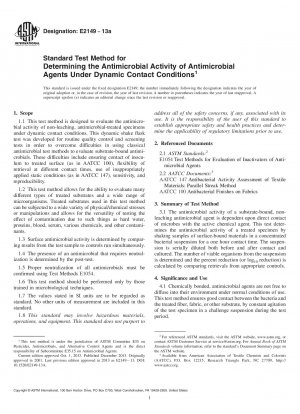ASTM E2149-13a
Standard Test Method for Determining the Antimicrobial Activity of Antimicrobial Agents Under Dynamic Contact Conditions
- Standard No.
- ASTM E2149-13a
- Release Date
- 2013
- Published By
- American Society for Testing and Materials (ASTM)
- Status
- Replace By
- ASTM E2149-20
- Latest
- ASTM E2149-20
- Scope
4.1 Chemically bonded, antimicrobial agents are not free to diffuse into their environment under normal conditions of use. This test method ensures good contact between the bacteria and the treated fiber, fabric, or other substrate, by constant agitation of the test specimen in a challenge suspension during the test period.
4.2 The metabolic state of the challenge species can directly affect measurements of the effectiveness of particular antimicrobial agents or concentrations of agents. The susceptibility of the species to particular biocides could be altered depending on its life stage (cycle). One-hour contact time in a buffer solution allows for metabolic stasis in the population. This test method standardizes both the growth conditions of the challenge species and substrate contact times to reduce the variability associated with growth phase of the microorganism.
4.3 Leaching of an antimicrobial is dependent upon the test conditions being utilized and the ultimate end use of the product. For example, water soluble antimicrobials will be prone to removal from the test surface using the method described in Section 13 but insoluble compounds will not. It is for this reason that the use of the term leaching throughout this document is limited to only the testing conditions described herein. To determine if a compound is immobilized in all conditions or during the end use of the product additional testing may be required.
4.4 This test method cannot determine if a compound is leaching into solution or is immobilized on the substrate. This test method is only intended to determine efficacy as described in 4.5 and subsequent portions of the method.
4.5 This test method is intended to evaluate antimicrobial agents that are not removed from the surface by the aqueous testing conditions, as evaluated by Section 13. If an antimicrobial agent that is shown to be removed from the surface by Section 13 is utilized in this test methodology, controls must be included such that appropriate neutralization steps are including during recovery and enumeration.
4.6 The test is suitable for evaluating stressed or modified specimens, when accompanied by adequate controls.
Note 1—Stresses may include laundry, wear and abrasion, radiation and steam sterilization, UV exposure, solvent manipulation, temperature susceptibility, or similar physical or chemical manipulation.1.1 This test method is designed to evaluate the antimicrobial activity of non-leaching, antimicrobial-treated specimens under dynamic contact conditions. This dynamic shake flask test was developed for routine quality control and screening tests in order to overcome difficulties in using classical antimicrobial test methods to evaluate substrate-bound antimicrobials. These difficulties include ensuring contact of inoculum to treated surface (as in AATCC 100), flexibility of retrieval at different contact times, use of inappropriately applied static conditions (as in AATCC 147), sensitivity, and reproducibility.
1.2 This test method allows for the ability to evaluate many different types of treated substrates and a wide range of microorganisms. Treated substrates used in this test method can be subjected to a wide v......
ASTM E2149-13a Referenced Document
- ASTM E1054 Standard Practices for Evaluation of Inactivators of Antimicrobial Agents
ASTM E2149-13a history
- 2020 ASTM E2149-20 Standard Test Method for Determining the Antimicrobial Activity of Antimicrobial Agents Under Dynamic Contact Conditions
- 2013 ASTM E2149-13a Standard Test Method for Determining the Antimicrobial Activity of Antimicrobial Agents Under Dynamic Contact Conditions
- 2013 ASTM E2149-13 Standard Test Method for Determining the Antimicrobial Activity of Immobilized Antimicrobial Agents Under Dynamic Contact Conditions
- 2010 ASTM E2149-10 Standard Test Method for Determining the Antimicrobial Activity of Immobilized Antimicrobial Agents Under Dynamic Contact Conditions
- 2001 ASTM E2149-01 Standard Test Method for Determining the Antimicrobial Activity of Immobilized Antimicrobial Agents Under Dynamic Contact Conditions

Copyright ©2024 All Rights Reserved